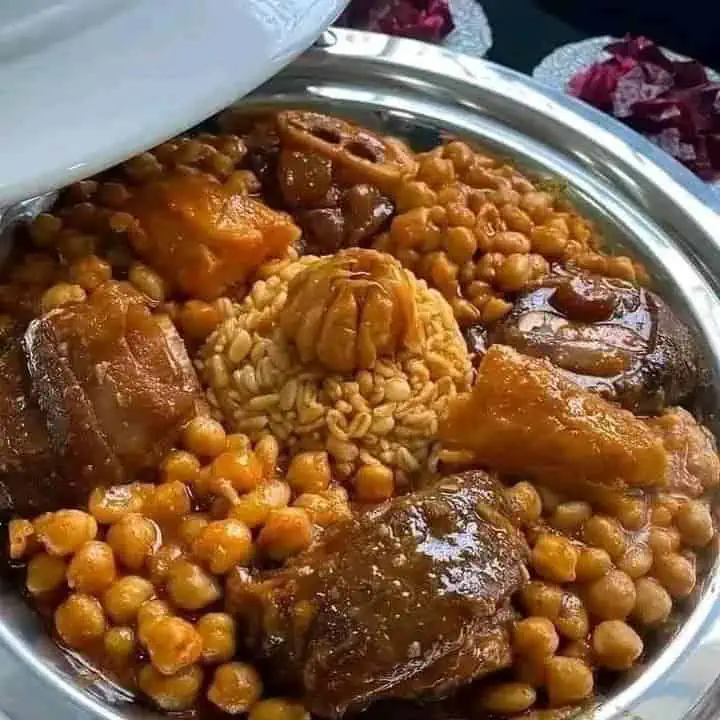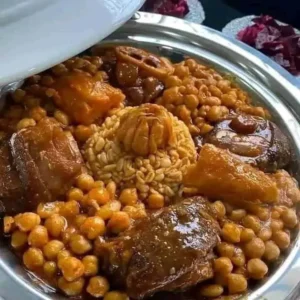Moroccan Cow Feet, known as Kawaj or Karnoun, is a rich, gelatinous dish that has been enjoyed in Moroccan households for generations. This slow-cooked delicacy is known for its deep flavor, high collagen content, and hearty texture, making it a nutrient-packed and comforting meal, especially during cold weather or Ramadan.
Table of Contents
What is Moroccan Cow Feet (Kawaj)?
Cow feet are slow-simmered in a flavorful broth, infused with spices, garlic, and herbs until the meat becomes tender and gelatinous. The dish is typically served with bread or alongside traditional Moroccan sides, offering a rich and warming experience.
Key Features of This Dish:
- Collagen-Rich & Nutritious – Supports joint, skin, and bone health.
- Deep Moroccan Spices – Infused with cumin, paprika, turmeric, and saffron.
- Slow-Cooked for Maximum Flavor – Results in a thick, hearty broth.
- Perfect for Special Occasions & Family Gatherings.
The Cultural Significance of Cow Feet in Moroccan Cuisine
- A Traditional Dish for Ramadan & Winter Months – Provides warmth, energy, and nourishment.
- Symbol of Resourcefulness – Uses every part of the animal, ensuring nothing goes to waste.
- Enjoyed Across North Africa & the Middle East – Variations exist in Algeria, Tunisia, and Egypt.
Health Benefits of Moroccan Cow Feet
Moroccan Cow Feet is not only a flavorful dish but also a nutritional powerhouse. Packed with collagen, essential minerals, and healthy fats, this dish supports joint health, digestion, and skin rejuvenation.
1. High Collagen Content for Joint and Skin Health
Collagen is the main structural protein in bones, skin, and connective tissues. Cow feet are one of the richest natural sources of collagen, offering several health benefits:
- Supports Joint Health – Helps reduce joint pain and stiffness.
- Improves Skin Elasticity – Boosts hydration and reduces wrinkles.
- Strengthens Hair & Nails – Encourages faster growth and less breakage.
- Aids Gut Health – Helps repair the gut lining, beneficial for digestion.
Tip: Drinking the broth from cow feet regularly enhances collagen absorption.
Health Benefits of Collagen in Bone Broth www.healthline.com
2. Rich in Minerals and Nutrients
Slow-cooked cow feet release essential minerals that support overall health.
| Mineral | Benefit |
|---|---|
| Calcium | Strengthens bones and teeth |
| Magnesium | Supports muscle and nerve function |
| Phosphorus | Helps with cell repair and metabolism |
| Iron | Prevents fatigue and boosts energy levels |
Tip: Pair Moroccan Cow Feet with lemon juice to enhance iron absorption.
3. A Nourishing Dish for Cold Weather
This dish is a popular winter meal in Morocco because it:
- Provides warmth and keeps the body energized in colder months.
- Supports the immune system with its rich broth and nutrient content.
- Promotes satiety, keeping you full for longer.
Tip: Serve Moroccan Cow Feet with spiced Moroccan tea for a complete warming meal.
Essential Ingredients for Moroccan Cow Feet Recipe
To create an authentic and flavorful Moroccan Cow Feet dish, choosing the right ingredients is key.
1. Choosing the Best Cow Feet
- Fresh or Frozen: Fresh cow feet are ideal, but frozen ones work well when properly thawed.
- Pre-Cleaned vs. Whole: Some butchers offer pre-cleaned and chopped cow feet, making preparation easier.
- Color & Smell: Choose pale pink or white cow feet with a neutral, fresh smell—avoid any with a strong odor.
Tip: Ask your butcher to chop the cow feet into smaller pieces for faster cooking and better flavor infusion.
2. Spices and Herbs That Enhance Flavor
Like many Moroccan dishes, this recipe depends on a blend of aromatic spices for a deep, earthy taste.
- Cumin (1 tsp) – Enhances the rich, meaty flavor.
- Paprika (1 tsp) – Adds mild sweetness and warmth.
- Turmeric (½ tsp) – Gives the dish a golden color and anti-inflammatory benefits.
- Ginger (½ tsp) – Brings a subtle spiciness.
- Black Pepper (½ tsp) – Balances the flavors with mild heat.
- Saffron (a few threads, optional) – Adds Moroccan authenticity.
- Salt (to taste) – Essential for seasoning the broth.

Tip: Toast the spices in olive oil before adding the cow feet for a richer aroma and deeper flavor.
3. Optional Ingredients for Customization
Different Moroccan families customize their cow feet recipe with additional ingredients:
For a More Complex Flavor:
- Preserved Lemon (½ chopped) – Adds a tangy depth.
- Garlic (3 cloves, minced) – Boosts aroma and enhances the broth.
- Tomatoes (1 large, grated) – Provides natural sweetness.
For Extra Protein:
- Chickpeas (1 cup, soaked overnight) – Makes the dish heartier.
- Lentils (½ cup) – Adds fiber and texture.
For a Spicy Kick:
- Harissa (1 tbsp, optional) – Brings Moroccan heat.
- Red Chili Flakes (½ tsp) – For a mild but warming spice.
Tip: If adding chickpeas or lentils, soak them overnight to reduce cooking time and improve texture.
How to Clean and Prepare Cow Feet for Cooking
Cleaning cow feet properly is essential to remove impurities and unwanted odors before cooking. Since cow feet contain thick skin, connective tissue, and bones, thorough cleaning ensures the best texture and taste.
1. Cleaning Techniques to Remove Impurities
Before cooking, cow feet must be scrubbed and boiled to eliminate dirt, hair, and excess fat.
Step-by-Step Cleaning Process:
- Rinse Thoroughly: Wash the cow feet under cold running water to remove surface dirt.
- Scald in Boiling Water:
- Place the cow feet in boiling water for 5 minutes.
- This loosens any remaining hair and makes them easier to clean.

3. Scrape Off Hair and Impurities:
- Use a knife or steel brush to scrape off any remaining hair or residue.
- If necessary, use a blowtorch to lightly burn off stubborn hairs.
4. Soak in Vinegar or Lemon Water:
- Fill a large bowl with water, ¼ cup vinegar, or lemon juice.
- Soak the cow feet for 20–30 minutes to neutralize any strong odors.
5. Final Rinse:
- Rinse again with cold water before cooking.
Tip: If using frozen cow feet, thaw them completely before cleaning.
2. How to Soften the Cow Feet Before Cooking
Since cow feet are tough and gelatinous, they require slow cooking or pressure cooking to soften properly.
Methods to Tenderize Cow Feet:
1. Pressure Cooker (Fastest Method):
- Cook for 40–50 minutes under high pressure with spices.
2. Stovetop Simmering (Traditional Method):
- Boil for 3–4 hours over low heat until tender.
3. Soaking Before Cooking:
- Some cooks soak cow feet in water with salt or lemon juice overnight to slightly soften the texture before cooking.
Tip: Always skim off any foam or impurities that rise to the surface while cooking for a clearer, cleaner broth.
Step-by-Step Moroccan Cow Feet Recipe
Now that the cow feet are cleaned and prepared, it’s time to cook them to perfection. This recipe includes both traditional stovetop and pressure cooker methods to suit your cooking preference.
1. Traditional Cooking Methods (Stovetop vs. Pressure Cooker)
Stovetop Method (Traditional & Slow-Cooked for Maximum Flavor)
- Cooking Time: 3–4 hours
- Best For: Deep, well-developed flavors with a rich broth.
Pressure Cooker Method (Faster & Convenient)
- Cooking Time: 40–50 minutes
- Best For: A quicker version while maintaining great taste.
Tip: If using the stovetop method, add extra water as the liquid reduces during long cooking.
2. Ingredients for Moroccan Cow Feet Recipe
Main Ingredients:
- 1 kg (2 lbs) cleaned cow feet, chopped
- 1 large onion, finely chopped
- 4 cloves garlic, minced
- ¼ cup olive oil
- 6 cups water or beef broth
Spices & Seasonings:
- 1 tsp cumin
- 1 tsp paprika
- ½ tsp turmeric
- ½ tsp ginger powder
- ½ tsp black pepper
- ½ tsp cinnamon (optional, for extra warmth)
- Salt (to taste)
- A few saffron threads (optional, for color and depth)
Optional Additions for More Flavor:
- 1 preserved lemon, chopped (adds a tangy, authentic Moroccan touch)
- 1 cup cooked chickpeas or lentils (for a heartier dish)
- 1 tbsp harissa (for a spicy version)
3. Step-by-Step Cooking Instructions
Step 1: Sauté the Aromatics
- In a large pot or pressure cooker, heat olive oil over medium heat.
- Add onions and garlic, stirring until they turn soft and golden (about 5 minutes).
- Stir in all the spices (cumin, paprika, turmeric, ginger, black pepper, and saffron).
- Cook for 1–2 minutes to release the aromas.
Tip: Toasting the spices in oil enhances their depth and richness.
Step 2: Cook the Cow Feet
- Add the cleaned cow feet to the pot and stir well to coat with the spices.
- Pour in water or beef broth, making sure the cow feet are fully submerged.
- Bring to a boil, then reduce heat to low for slow cooking (or seal the pressure cooker).
Step 3: Cooking Time & Tenderizing
For Stovetop Cooking:
- Cover and simmer for 3–4 hours, stirring occasionally.
- If needed, add more water to maintain broth consistency.
For Pressure Cooker:
- Seal and cook on high pressure for 40–50 minutes.
- Allow natural release of pressure before opening the lid.
Tip: The cow feet are done when they are tender and gelatinous, and the broth has thickened into a rich sauce.
Step 4: Final Touches & Serving
- If using, stir in chickpeas or lentils in the last 20 minutes of cooking.
- Adjust salt and seasoning to taste.
- Garnish with preserved lemon slices and extra cumin before serving.

Tip: Let the dish rest for 10 minutes before serving to allow flavors to settle.
4. Tips for Achieving the Perfect Gelatinous Texture
- For a Thicker Sauce: Simmer uncovered for the last 15 minutes to reduce excess liquid.
- For Extra Richness: Let the cow feet sit in the broth for a few hours before reheating.
- To Balance the Gelatinous Texture: Serve with a squeeze of lemon juice to cut through the richness.
Variations of Moroccan Cow Feet Dish
While the traditional Moroccan Cow Feet (Kawaj) is a slow-cooked, spiced broth dish, many regional and household variations exist. Whether you prefer it spicier, thicker, or combined with legumes, these adaptations allow you to customize the dish to your liking.
1. Spicy Harira-Style Cow Feet
For those who enjoy a spicier, soupier version, this variation combines Moroccan Harira flavors with cow feet.
How to Make It Spicy:
- Add 1 tbsp harissa or 1 tsp cayenne pepper for heat.
- Use grated tomatoes for a more soup-like texture.
- Include lentils and chickpeas to add heartiness.
Tip: Serve with lemon wedges to enhance the tangy, spicy balance.
2. Slow-Cooked Moroccan Cow Feet Tagine
A tagine-style preparation creates a thicker, richer version of Moroccan Cow Feet by slow-cooking it in clay cookware.
How to Cook it in a Tagine:
- Reduce the water amount to create a thicker sauce.
- Add preserved lemon and olives for extra Moroccan depth.
- Let it cook over low heat for 4–5 hours until it reaches a deep, concentrated flavor.
Tip: Pair with steamed couscous or flatbread for a complete meal.
3. Cow Feet with Chickpeas and Lentils
For a fiber-packed variation, add legumes for extra texture and nutrition.
How to Add Legumes:
- Use 1 cup of chickpeas (soaked overnight) and add them in the last 20 minutes of cooking.
- Include ½ cup of lentils to naturally thicken the broth.
- For a creamy version, blend part of the chickpeas before serving.
Tip: This version balances the gelatinous texture with extra bite from the legumes.
4. Additional Customization Ideas
For a Smoky Flavor:
- Roast the garlic before adding it to the broth.
- Sprinkle in smoked paprika for depth.
For a Healthier Version:
- Use less olive oil and opt for leaner cuts with less bone marrow.
- Serve with steamed vegetables instead of bread.
For a Festive Version:
- Add dates or prunes for a sweet-savory touch, like in Moroccan tagines.
- Garnish with toasted almonds and cinnamon before serving.
Tip: Experimenting with regional spices and ingredients can create unique, personalized versions of Moroccan Cow Feet.
From spicy Harira-style cow feet to rich, slow-cooked tagine versions, Moroccan Cow Feet is a versatile dish that can be adapted to different taste preferences and dietary needs.
serving and storing Moroccan Cow Feet
1. Best Ways to Serve and Pair Moroccan Cow Feet
- Traditional Moroccan Side Dishes:
- Served with Moroccan khobz (bread) to soak up the rich broth.
- Pairs well with steamed couscous or rice for a complete meal.
- Can be accompanied by pickled lemons, olives, or spicy harissa.
2. Best Drinks to Complement the Dish:
- Moroccan mint tea helps balance the richness.
- Lemon-infused water enhances digestion.
- Fermented milk (lben) provides a cooling contrast.
3. Serving Presentation Tips:
- Garnish with fresh parsley, cumin, or preserved lemon slices.
- Serve in deep bowls to keep the broth warm longer.
2. Storing and Reheating Moroccan Cow Feet
- Refrigeration: Store in an airtight container for up to 4 days in the fridge.
- Freezing: Freeze in portions for up to 3 months.
- Tip: Freeze with some broth to retain moisture when reheating.

3. Best Reheating Methods:
- Stovetop: Reheat over low heat, adding a bit of water if needed.
- Microwave: Use short intervals, stirring in between.
- Tip: Let it sit for a few minutes after reheating to allow flavors to settle.
3. Common Mistakes to Avoid When Cooking Cow Feet
- Overcooking or Undercooking the Meat: Use slow cooking or a pressure cooker for perfect tenderness.
- Not Using Enough Spices: Moroccan dishes rely on cumin, paprika, and garlic for bold flavors.
- Skipping the Marinating Process: Letting the cow feet soak in spices before cooking enhances taste.
- Ignoring the Cleaning Process: Properly scrub, boil, and soak the cow feet to remove impurities and odors.
Frequently Asked Questions About Moroccan Cow Feet
Is Moroccan Cow Feet Healthy?
- Yes! It is rich in collagen, minerals, and nutrients for joint and skin health.
Can I Cook Cow Feet Without a Pressure Cooker?
- Yes, but it requires 3–4 hours of slow cooking on the stovetop.
How Do I Make a Less Gelatinous Version?
- Add extra broth, chickpeas, or vegetables to balance the texture.
What Other Meats Can Be Combined with Cow Feet?
- Beef shank, lamb, or veal can be added for variety.
Moroccan Cow Feet Recipe
Equipment
- Large pot or pressure cooker
- Knife
- Cutting board
- Mixing spoon
Ingredients
Main Ingredients
- 1 kg cleaned cow feet Chopped into pieces.
- 1 large onion Finely chopped.
- 4 cloves garlic Minced.
- ¼ cup olive oil For sautéing.
- 6 cups water or beef broth Enough to fully submerge the cow feet.
Spices & Seasonings
- 1 tsp cumin For warmth and depth.
- 1 tsp paprika Adds mild sweetness and color.
- ½ tsp turmeric For color and an earthy taste.
- ½ tsp ginger powder Adds warmth and subtle spice.
- ½ tsp black pepper For mild heat.
- ½ tsp cinnamon Optional, for extra warmth.
- salt To taste.
- saffron threads Optional, for color and depth.
Optional Additions for More Flavor
- 1 preserved lemon Chopped, adds a tangy Moroccan touch.
- 1 cup cooked chickpeas or lentils For a heartier dish.
- 1 tbsp harissa For a spicy version.
Instructions
- Heat olive oil in a large pot or pressure cooker over medium heat.
- Add chopped onions and minced garlic, stirring until soft and golden (about 5 minutes).
- Stir in all the spices (cumin, paprika, turmeric, ginger, black pepper, and saffron). Cook for 1–2 minutes to release their aromas.
- Add the cleaned cow feet and stir well to coat with the spices.
- Pour in water or beef broth, ensuring the cow feet are fully submerged.
- For stovetop cooking: Cover and simmer for 3–4 hours, stirring occasionally. Add more water if needed.
- For pressure cooker: Seal and cook on high pressure for 40–50 minutes. Allow natural release before opening.
- If using, stir in chickpeas or lentils in the last 20 minutes of cooking.
- Adjust salt and seasoning to taste.
- Garnish with preserved lemon slices and extra cumin before serving.
Notes
Conclusion
Why You Should Try Moroccan Cow Feet
Moroccan Cow Feet, also known as Kawaj or Karnoun, is a rich, flavorful, and deeply nourishing dish that holds a special place in traditional Moroccan cuisine. Whether enjoyed for its health benefits, cultural significance, or unique taste, it is a dish worth trying.
Key Takeaways:
- Highly Nutritious: Packed with collagen, minerals, and protein, making it excellent for joint health, skin, and digestion.
- Versatile & Customizable: Can be prepared spicy, with chickpeas, or as a slow-cooked tagine.
- Perfect for Special Occasions: Commonly enjoyed during Ramadan, winter months, and family gatherings.
- Best Served with Moroccan Sides: Complements khobz (bread), couscous, mint tea, and pickled lemons.
- Ideal for Meal Prep: Stores well in the fridge or freezer, making it easy to reheat and enjoy later.
Final Thoughts on Moroccan Cow Feet
If you love slow-cooked, deeply spiced Moroccan dishes, Moroccan Cow Feet is a must-try. Whether you’re looking for a nutrient-rich comfort meal or an authentic North African culinary experience, this dish is a true taste of Moroccan heritage.
For more Recipes to Try
Check out these recipes:
- Amlou: The best Moroccan Almond and Argan Oil Spread Recipe
- 7 Moroccan Couscous Recipes: Authentic Recipes, Variations, and Health Benefits


